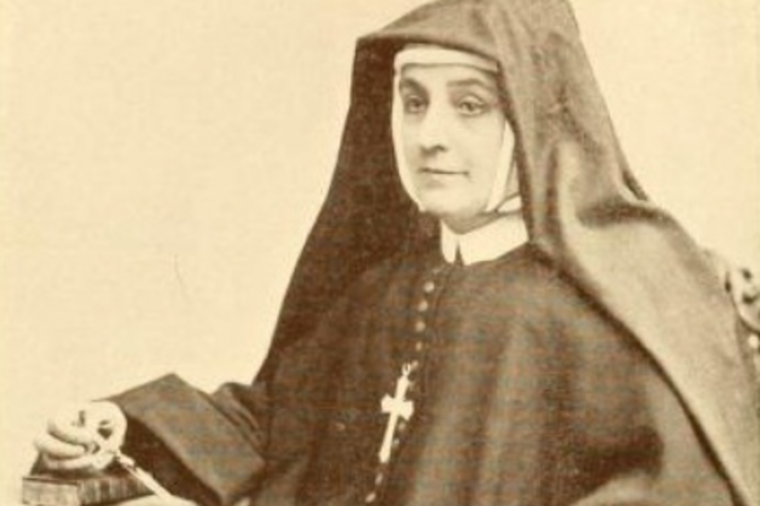The Venerable Cornelia Connelly (1809-1879), pictured around 1877. Public Domain.
A religious order announced yesterday that it had withdrawn an application to exhume the body of its US-born founder following an outcry in England, where the nun is buried.
In a statement issued yesterday, the Society of the Holy Child Jesus said that it had abandoned plans to transfer part of the mortal remains of the Venerable Cornelia Connelly to Philadelphia.
“A decision has been made to withdraw the application to the Historic Churches Commission for the exhumation of the Venerable Cornelia Connelly,” said the statement signed by Veronica Openibo, Pauline Darby, Cecilia Nya, and Marie Ursino, members of the Society Leadership Team.
Connelly, who was born in Philadelphia in 1809, died in 1879 in the English town of St. Leonards-on-Sea, where she founded a school.
The mother of five, convert, and founder of a religious congregation was buried in the Convent Cemetery in Mayfield, East Sussex. But her body was moved in 1935 to the chapel of Mayfield School, which she established in 1872.
Her order hoped to transfer her remains to the Cathedral Basilica of Saints Peter and Paul, Philadelphia. An announcement about the move was still visible on the cathedral’s website yesterday morning but was later removed.
It said: “The sacred remains of the foundress of the Society of the Holy Child Jesus, Venerable Cornelia Connelly, soon will be translated from England to a new tomb in our Cathedral Basilica.”
“Venerable Cornelia Connelly is a native Philadelphian and her cause for canonization is well underway. Her tomb will be located in the rear of the Basilica on the Race Street side.”
The announcement included a poster with an artist’s drawing, with the title “The future home of the Venerable Cornelia Connelly tomb.”
The proposal encountered fierce opposition when the order applied to the Southern Historic Churches Committee for permission to extract Connelly’s coffin before returning it through an opening made in the side wall of the 14th-century chapel below ground level.
The Tablet, a British Catholic weekly, reported on 19 February that the committee had received 120 objections to the plan. A petition against the exhumation gained more than 1,400 supporters.
The order initially defended the proposal, saying that Connelly’s remains would “provide an important focus for veneration” at the Cathedral Basilica of Saints Peter and Paul ahead of potential developments in her canonization cause.
“Remains would also be retained at Mayfield School, continuing the long tradition of the veneration of the foundress by Sisters of the Holy Child Jesus, members of the school community and others who come to the chapel for prayer,” a spokesperson said.
“We are saddened by any pain and upset this move causes. The society believes that by being in the cathedral, alongside St. Katherine Drexel, another Philadelphia founder, Cornelia’s life, legacy and our charism will have the potential to be recognized, seen and shared by a larger number of people, allowing a greater spotlight on her work and cause for canonization.”
According to a biography on the order’s website, Connelly was born into an affluent family and raised as a Presbyterian. After she was orphaned at the age of 14, she was baptized in the Episcopal Church and married a clergyman, the Rev. Pierce Connelly.
The marriage was reportedly happy, although one of their five children died at the age of six weeks and another died at the age of two after being knocked into a vat of boiling sugar by a dog.
Both she and her husband converted to Catholicism. Pierce Connelly believed that he had a vocation to the Catholic priesthood. In 1845, she took a vow of perpetual chastity, enabling her husband to train for the priesthood, after he refused to heed her requests to reconsider.
She then began to explore a vocation to religious life, desiring to found an order called the Society of the Holy Child Jesus. Pope Gregory XVI asked her to establish the foundation in England, which was undergoing a Catholic revival after centuries of persecution. She founded the order in 1846.
She became involved in a painful dispute with her husband, who demanded that she return to him. In 1849, he filed suit in a British court. The case, which was highly publicized, was finally dismissed in 1858.
In 1862, six sisters from England brought the Society to the United States. Today the order is present in North America, Latin America, Africa, and Europe.
The first steps to open Connelly’s canonization cause took place in 1953. Pope John Paul II declared her “Venerable” in 1992, recognizing that her life was marked by heroic virtue.
Source: CNA

